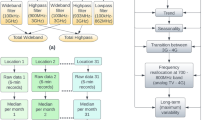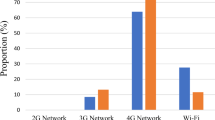Abstract
In this study, radio frequency electromagnetic field exposure levels were measured on the main streets in the city center of Diyarbakır, Turkey. Measured electric field levels were plotted on satellite imagery of Diyarbakır and were compared with exposure guidelines published by the International Commission on Non-Ionizing Radiation Protection (ICNIRP). Exposure measurements were performed in dense urban, urban and suburban areas each day for 7 consecutive days. The measurement system consisted of high precision and portable spectrum analyzer, three-axis electric field antenna, connection cable and a laptop which was used to record the measurement samples as a data logger. The highest exposure levels were detected for two places, which are called Diclekent and Batıkent. It was observed that the highest instantaneous electric field strength value for Batıkent was 7.18 V/m and for Diclekent was 5.81 V/m. It was statistically determined that the main contributor band to the total exposure levels was Universal Mobile Telecommunications System band. Finally, it was concluded that all measured exposure levels were lower than the reference levels recommended by ICNIRP for general public health.
This is a preview of subscription content, access via your institution
Access options
Subscribe to this journal
Receive 6 print issues and online access
$259.00 per year
only $43.17 per issue
Buy this article
- Purchase on Springer Link
- Instant access to full article PDF
Prices may be subject to local taxes which are calculated during checkout


Similar content being viewed by others
References
Baliatsas C, Van Kamp I, Bolte J, Schipper M, Yzermans J, Lebret E . Non-specific physical symptoms and electromagnetic field exposure in the general population: can we get more specific? A systematic review. Environ Int 2012; 41: 15–28.
Berg G, Schüz J, Samkange-Zeeb F, Blettner M . Assessment of radiofrequency exposure from cellular telephone daily use in an epidemiological study: German Validation study of the international case–control study of cancers of the brain—INTERPHONE-Study. J Expo Anal Environ Epidemiol 2005; 15: 217–224.
Viel JF, Cardis E, Moissonnier M, de Seze R, Hours M . Radiofrequency exposure in the French general population: Band, time, location and activity variability. Environ Int 2009; 35: 1150–1154.
Vrijheid M . Validation of short term recall of mobile phone use for the interphone study. Occup Environ Med 2006; 63: 237–243.
Samkange-Zeeb F, Berg G, Blettner M . Validation of self-reported cellular phone use. J Expo Anal Environ Epidemiol 2004; 14: 245–248.
Schüz J, Mann S . A discussion of potential exposure metrics for use in epidemiological studies on human exposure to radiowaves from mobile phone base stations. J Expo Anal Environ Epidemiol 1999; 10: 600–605.
IARC. IARC classifies radiofrequency electromagnetic fields as possibly carcinogenic to humans. Int Agency Res Cancer 2011; 2008: 1–6.
Balmori A, Hallberg O . The urban decline of the house sparrow (Passer domesticus): a possible link with electromagnetic radiation. Electromagn Biol Med 2007; 26: 141–151.
Balmori A . Possible effects of electromagnetic fields from phone masts on a population of white stork (Ciconia ciconia). Electromagn Biol Med 2005; 24: 109–119.
Tkalec M, Malarić K, Pevalek-Kozlina B . Influence of 400, 900, and 1900 MHz electromagnetic fields on Lemna minor growth and peroxidase activity. Bioelectromagnetics 2005; 26: 185–193.
Brumelis Balodis G, Kalviskis K, Nikodemus O, Tjarve D, Znotina V V . Does the Skrunda Radio Location Station diminish the radial growth of pine trees? Sci Total Environ 1996; 180: 57–64.
WHO. Electromagnetic fields and public health: mobile phones. http://www.who.int/mediacentre/factsheets/fs193/en/ (last accessed date 8 August 2016).
Bolte JFB, Eikelboom T . Personal radiofrequency electromagnetic field measurements in the Netherlands: exposure level and variability for everyday activities, times of day and types of area. Environ Int 2012; 48: 133–142.
Joseph W, Frei P, Roösli M, Thuróczy G, Gajsek P, Trcek T et al. Comparison of personal radio frequency electromagnetic field exposure in different urban areas across Europe. Environ Res 2010; 110: 658–663.
Radon K, Spegel H, Meyer N, Klein J, Brix J, Wiedenhofer A et al. Personal dosimetry of exposure to mobile telephone base stations? An epidemiologic feasibility study comparing the Maschek dosimeter prototype and the antennessa DSP-090 system. Bioelectromagnetics 2006; 27: 77–81.
Urbinello D, Joseph W, Huss A, Verloock L, Beekhuizen J, Vermeulen R et al. Radio-frequency electromagnetic field (RF-EMF) exposure levels in different European outdoor urban environments in comparison with regulatory limits. Environ Int 2014; 68: 49–54.
Calvente I, Fernández MF, Pérez-Lobato R, Dávila-Arias C, Ocón O, Ramos R et al. Outdoor characterization of radio frequency electromagnetic fields in a Spanish birth cohort. Environ Res 2015; 138: 136–143.
Cooper TG, Mann SM, Khalid M, Blackwell RP . Public exposure to radio waves near GSM microcell and picocell base stations. J Radiol Prot 2006; 26: 199–211.
Korpinen L, Paakkonen R . Examples of occupational exposure to electric and magnetic fields at 110-kV gas-insulated substations (GISs). Radiat Prot Dosimetry 2015; 163: 394–397.
Koprivica M, Petrić M, Nešković N, Nešković A . Statistical analysis of electromagnetic radiation measurements in the vicinity of indoor microcell GSM/UMTS base stations in Serbia. Bioelectromagnetics 2016; 37: 69–76.
Genç Ö, Bayrak M, Yaldız E . Analysis of the effects of GSM bands to the electromagnetic pollution in the rf spectrum. Prog Electromagn Res 2010; 101: 17–32.
ICNIRP. Guidelines for limiting exposure to time-varying electric, magnetic, and electromagnetic fields (up to 300 GHz). Health Phys 1998; 74: 494–522.
IEEE. IEEE Standard for Safety Levels with Respect to Human Exposure to Radio Frequency Electromagnetic Fields, 3 kHz to 300 GHz. IEEE Std C951-2005 (Revision IEEE Std C95.1-1991). 2005; 1–238.
FCC. Evaluating Compliance with FCC Guidelines for Human Exposure to Radiofrequency Electromagnetic Fields. 1997.
Narda. SRM-3006 Selective Radiation Meter Operating Manual. 2012.
Narda. Applicaton Note GSM measurements with the Selective Radiation Meter. 2007; 1–10.
Narda. Application Note Measurements on radio and TV transmitters. 2010; 1–12.
Narda. Application Note UMTS measurements with the Selective Radiation Meter. 2008; 1–11.
MapInfo. MapInfo Professional Version 10.0.1 Release Build 220. MapInfo Prof Version 1001 Release Build 220. 2009.
Seyfi L . Measurement of electromagnetic radiation with respect to the hours and days of a week at 100kHz-3GHz frequency band in a Turkish dwelling. Meas J Int Meas Confed 2013; 46: 3002–3009.
Verloock L, Joseph W, Goeminne F, Martens L, Verlaek M, Constandt K . Temporal 24-hour assessment of radio frequency exposure in schools and homes. Measurement 2014; 56: 50–57.
Acknowledgements
This work was supported by Dicle University Scientific Research Projects (Project Number: 13-MF-25)
Author information
Authors and Affiliations
Corresponding author
Ethics declarations
Competing interests
The authors declare no conflict of interest.
Rights and permissions
About this article
Cite this article
Cansiz, M., Abbasov, T., Kurt, M. et al. Mapping of radio frequency electromagnetic field exposure levels in outdoor environment and comparing with reference levels for general public health. J Expo Sci Environ Epidemiol 28, 161–165 (2018). https://doi.org/10.1038/jes.2016.64
Received:
Accepted:
Published:
Issue Date:
DOI: https://doi.org/10.1038/jes.2016.64
Keywords
This article is cited by
-
Spatial variability of outdoor exposure to radiofrequency radiation from mobile phone base stations, in Khartoum, Sudan
Environmental Science and Pollution Research (2022)
-
Comprehensive radiofrequency electromagnetic field measurements and assessments: a city center example
Environmental Monitoring and Assessment (2020)



